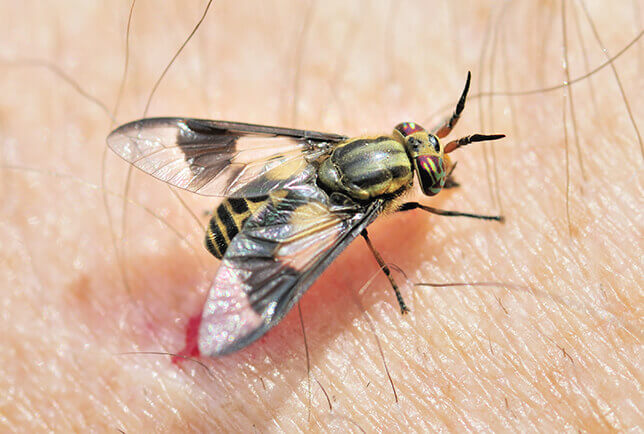What Do Deer Flies Look Like?
The term deer fly refers to several types of flies common throughout New England. The pests have large patterned eyes, dark banded wings, and brown- or black-striped bodies. Depending on the species, deer flies may be up to a half-inch in length.
A female deer fly can lay a mass of 100 to 1,000 eggs at once. These eggs turn dark gray or black before the larvae emerge in about 14 days. Deer fly maggots have small heads and tan or white tapered bodies, but you’re unlikely to see them. Newly-hatched larvae burrow quickly into wet soil and sediment to feed on organic matter.
How Can I Tell if I Have a Deer Fly Problem?
Deer flies and their young are strictly outdoor pests, but those who live close to shorelines, marshes, or lakes, may notice signs of infestation around their property:
- Light Swarms – Adult deer flies are attracted to bright lighting, so you might spot these pests near porch lights, post lamps, or outdoor hanging lights.
- Bites – Similar to a bee sting, a deer fly bite quickly develops into an itchy red welt.
- Timing – If you or your pets keep getting bitten in the early morning hours or at dusk on warm, sunny days, deer flies are probably the culprit.
How Do Deer Flies Get Inside Homes and Businesses?
While they don’t typically enter buildings, deer flies can accidentally wander indoors from time to time. Houses or hotels with swimming pools could have more issues with the pest because shiny surfaces and quick movements attract deer flies to people.
Restaurants and shops that prop doors and windows open on warm days may find these pests indoors. Deer flies also seek out light, so businesses with brightly-lit signs and storefronts can become a prime target.
Are Deer Flies Dangerous?
Female deer flies in search of blood meals deliver sharp, painful bites. Redness and swelling are normal after an attack, but some people experience a severe allergic reaction to the pests’ saliva and need medical care. Deer flies are also vectors for Lyme disease and tularemia, which can spread to humans and animals.
Stores, restaurants, and resorts in coastal areas often see revenues drop when deer fly populations increase. Guests accosted by these pests at hotel pools sometimes leave poor reviews and may even shorten their stays. Deer flies affect recreational activities like hiking and gardening, too. They can also make life miserable for landscaping crews, construction workers, and others with outdoor jobs.
How Can I Prevent Deer Fly Infestations?
As with most types of flies, keeping doors and windows closed prevents the pests from entering homes and businesses. Repellents rarely affect the insects, so wearing pants and light-colored long sleeve shirts is the best tactic to avoid bites. If you suspect a deer fly infestation on your property, contact the professionals at Waltham Pest Services.
